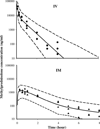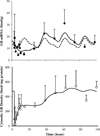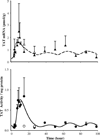Modeling receptor/gene-mediated effects of corticosteroids on hepatic tyrosine aminotransferase dynamics in rats: dual regulation by endogenous and exogenous corticosteroids
- PMID: 17593325
- PMCID: PMC4180077
- DOI: 10.1007/s10928-007-9063-3
Modeling receptor/gene-mediated effects of corticosteroids on hepatic tyrosine aminotransferase dynamics in rats: dual regulation by endogenous and exogenous corticosteroids
Abstract
Receptor/gene-mediated effects of corticosteroids on hepatic tyrosine aminotransferase (TAT) were evaluated in normal rats. A group of normal male Wistar rats were injected with 50 mg/kg methylprednisolone (MPL) intramuscularly at the nadir of their plasma corticosterone (CST) rhythm (early light cycle) and sacrificed at various time points up to 96 h post-treatment. Blood and livers were collected to measure plasma MPL, CST, hepatic glucocorticoid receptor (GR) mRNA, cytosolic GR density, TAT mRNA, and TAT activity. The pharmacokinetics of MPL showed bi-exponential disposition with two first-order absorption components from the injection site and bioavailability was 21%. Plasma CST was reduced after MPL dosing, but resumed its daily circadian pattern within 36 h. Cytosolic receptor density was significantly suppressed (90%) and returned to baseline by 72 h resuming its biphasic pattern. Hepatic GR mRNA follows a circadian pattern which was disrupted by MPL and did not return during the study. MPL caused significant down-regulation (50%) in GR mRNA which was followed by a delayed rebound phase (60-70 h). Hepatic TAT mRNA and activity showed up-regulation as a consequence of MPL, and returned to their circadian baseline within 72 and 24 h of treatment. A mechanistic receptor/gene-mediated pharmacokinetic/pharmacodynamic model was able to satisfactorily describe the complex interplay of exogenous and endogenous corticosteroid effects on hepatic GR mRNA, cytosolic free GR, TAT mRNA, and TAT activity in normal rats.
Figures







Similar articles
-
Fourth-generation model for corticosteroid pharmacodynamics: a model for methylprednisolone effects on receptor/gene-mediated glucocorticoid receptor down-regulation and tyrosine aminotransferase induction in rat liver.J Pharmacokinet Biopharm. 1998 Jun;26(3):289-317. doi: 10.1023/a:1023233409550. J Pharmacokinet Biopharm. 1998. PMID: 10098101
-
Dose-dependence and repeated-dose studies for receptor/gene-mediated pharmacodynamics of methylprednisolone on glucocorticoid receptor down-regulation and tyrosine aminotransferase induction in rat liver.J Pharmacokinet Biopharm. 1998 Dec;26(6):619-48. doi: 10.1023/a:1020746822634. J Pharmacokinet Biopharm. 1998. PMID: 10485078
-
Third-generation model for corticosteroid pharmacodynamics: roles of glucocorticoid receptor mRNA and tyrosine aminotransferase mRNA in rat liver.J Pharmacokinet Biopharm. 1995 Apr;23(2):163-81. doi: 10.1007/BF02354270. J Pharmacokinet Biopharm. 1995. PMID: 8719235
-
Modeling of corticosteroid effects on hepatic low-density lipoprotein receptors and plasma lipid dynamics in rats.Pharm Res. 2008 Apr;25(4):769-80. doi: 10.1007/s11095-007-9371-8. Epub 2007 Aug 3. Pharm Res. 2008. PMID: 17674160 Free PMC article.
-
Pharmacokinetics and receptor-mediated pharmacodynamics of corticosteroids.Toxicology. 1995 Sep 1;102(1-2):189-96. doi: 10.1016/0300-483x(95)03047-j. Toxicology. 1995. PMID: 7482553 Review.
Cited by
-
Mechanism-based pharmacokinetic-pharmacodynamic modeling of bidirectional effect of danshensu on plasma homocysteine in rats.Pharm Res. 2009 Aug;26(8):1863-73. doi: 10.1007/s11095-009-9899-x. Epub 2009 May 7. Pharm Res. 2009. PMID: 19421844
-
Receptor/gene/protein-mediated signaling connects methylprednisolone exposure to metabolic and immune-related pharmacodynamic actions in liver.J Pharmacokinet Pharmacodyn. 2018 Aug;45(4):557-575. doi: 10.1007/s10928-018-9585-x. Epub 2018 Apr 27. J Pharmacokinet Pharmacodyn. 2018. PMID: 29704219 Free PMC article.
-
Modeling autonomic regulation of cardiac function and heart rate variability in human endotoxemia.Physiol Genomics. 2011 Aug 24;43(16):951-64. doi: 10.1152/physiolgenomics.00040.2011. Epub 2011 Jun 14. Physiol Genomics. 2011. PMID: 21673075 Free PMC article.
-
Quantitative tissue-specific dynamics of in vivo GILZ mRNA expression and regulation by endogenous and exogenous glucocorticoids.Physiol Rep. 2015 Jun;3(6):e12382. doi: 10.14814/phy2.12382. Physiol Rep. 2015. PMID: 26056061 Free PMC article.
-
Mechanistic Multi-Tissue Modeling of Glucocorticoid-Induced Leucine Zipper Regulation: Integrating Circadian Gene Expression with Receptor-Mediated Corticosteroid Pharmacodynamics.J Pharmacol Exp Ther. 2017 Oct;363(1):45-57. doi: 10.1124/jpet.117.242990. Epub 2017 Jul 20. J Pharmacol Exp Ther. 2017. PMID: 28729456 Free PMC article.
References
-
- Czock D, Keller F, Rasche FM, Haussler U. Pharmacokinetics and pharmacodynamics of sys-temically administered glucocorticoids. Clin Pharmacokinet. 2005;44:61–98. - PubMed
-
- Bagdade JD, Porte D, Jr, Bierman EL. Steroid-induced lipemia. A complication of high-dosage corticosteroid therapy. Arch Int Med. 1970;125:129–134. - PubMed
-
- Schacke H, Docke WD, Asadullah K. Mechanisms involved in the side effectsof glucocorticoids. Pharmacol Ther. 2002;96:23–43. - PubMed
-
- Staels B. When the clock stops ticking, metabolic syndrome explodes. Nat Med. 2006;12:54–55. - PubMed
-
- Wilcke JR, Davis LE. Review of glucocorticoid pharmacology. Vet Clin North America - Small Anim Pract. 1982;12:3–17. - PubMed
Publication types
MeSH terms
Substances
Grants and funding
LinkOut - more resources
Full Text Sources

